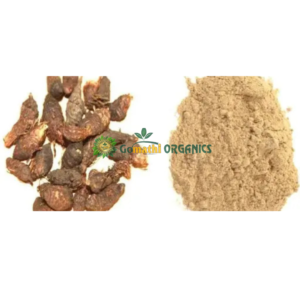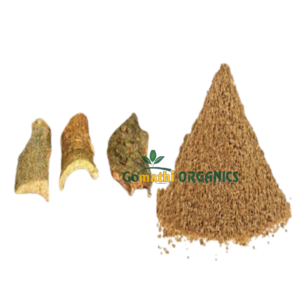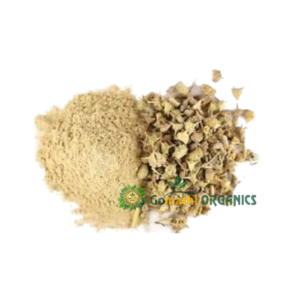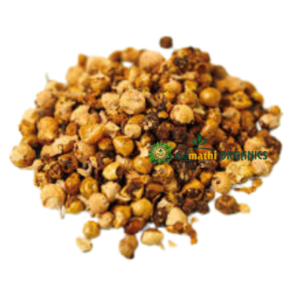🌿 What is Naval Seed Powder?
Naval Seed Powder is made from the sun-dried seeds of the Jamun fruit (Syzygium cumini), known as Naval Pazham in Tamil. Highly esteemed in Siddha, Ayurveda, and Unani medicine, these seeds are valued for their potent anti-diabetic, astringent, and digestive properties. Traditionally, they are used to regulate blood sugar, improve digestion, support liver health, and promote skin clarity.
🌳 Botanical Description
-
Botanical Name: Syzygium cumini
-
Common Names: Naval (Tamil), Jamun (Hindi), Java Plum (English)
-
Family: Myrtaceae
-
Type: Tropical, evergreen tree
-
Leaves: Glossy, opposite, aromatic when crushed
-
Fruit: Oval, dark purple-black berries with a single seed
-
Seed: Hard, oval-shaped; pale brown or grayish when dried
-
Taste: Astringent, slightly bitter
🌎 Habitat & Cultivation
Naval trees thrive in tropical and subtropical climates, found across India, Sri Lanka, Southeast Asia, and parts of Africa. They prefer deep, loamy soil and require full sun. Fruits are harvested in summer; seeds are separated, cleaned, and shade-dried before being ground into powder.
🌟 Key Benefits of Naval Seed Powder
-
Regulates Blood Sugar – Supports insulin sensitivity; reduces post-meal spikes
-
Improves Digestion – Aids in nutrient absorption; reduces bloating
-
Strengthens Liver Function – Detoxifies and supports bile flow
-
Controls Acidity – Alkalizing effect on stomach
-
Tightens Skin & Gums – Astringent action for oral and skin health
-
Enhances Metabolism – Helps manage weight and sugar cravings
-
Supports Urinary Health – Reduces frequency and discomfort
🧪 Active Compounds
-
Jamboline – Hypoglycemic alkaloid; controls glucose release
-
Tannins – Natural astringents; tone tissues and reduce inflammation
-
Flavonoids – Antioxidants that protect against oxidative stress
-
Gallic Acid – Anti-inflammatory and antimicrobial
-
Ellagic Acid – Supports liver detox and skin clarity
🍵 How to Use
For Diabetes Management (Internal)
➤ Take ¼–½ tsp of powder with warm water twice daily before meals
➤ Regular use under supervision helps maintain stable sugar levels
For Digestion & Detox
➤ Mix ¼ tsp with buttermilk or lemon water after meals
➤ Aids digestion and prevents gas/acidity
For Skin & Acne (External)
➤ Mix powder with rose water or aloe vera gel
➤ Apply as a face pack; leave 10–15 mins
➤ Rinse with cool water — helps tighten pores and reduce oiliness
As Herbal Tea
➤ Boil 1 tsp powder in 1 cup water for 5 mins
➤ Strain and sip lukewarm (optionally add cinnamon or dry ginger)
⚠️ Caution & Tips
-
Consult a practitioner before using for diabetes, especially with medication
-
Not recommended for hypoglycemics without supervision
-
Always ensure powder is made from food-grade, sun-dried seeds
-
Do a patch test before topical use
📦 Storage Guidelines
🌱 Ethical & Traditional Notes
-
Use seeds from organically grown Naval trees
-
Sun-dry thoroughly to prevent mold and retain potency
-
Traditionally ground on stone for therapeutic energy
-
Supports rural harvesting communities and herbal traditions
🍃 Nutritional Facts, Info & Dosage
Naval Seed Powder (Syzygium cumini) is primarily valued for its therapeutic phytochemicals rather than as a conventional nutrient-dense food. In traditional Siddha and Ayurvedic systems, it is used for its hypoglycemic, digestive, and astringent actions, particularly in managing blood sugar and metabolic health.
✅ Nutritional & Phytochemical Highlights (per 100g dried seed powder)
(Values are approximate and can vary with soil, climate, and processing method)
-
Energy: ~320 kcal
-
Dietary Fiber: 30–35 g
-
Protein: 12–15 g
-
Carbohydrates: ~35–40 g (mostly complex & fiber-bound)
-
Fats: ~1–2 g
-
Calcium: 150–180 mg
-
Iron: 3–5 mg
-
Magnesium: 40–60 mg
-
Potassium: 300–350 mg
-
Flavonoids: ~1–1.5%
-
Tannins: Moderately present (astringent action)
-
Jamboline & Jambosine: Present – known for glucose-regulating properties
-
Gallic Acid & Ellagic Acid: Antioxidant and anti-inflammatory compounds
🔍 Medicinal Actions According to Traditional Medicine
-
Rasa (Taste): Kashaya (astringent), Tikta (bitter)
-
Guna (Qualities): Laghu (light), Ruksha (dry)
-
Virya (Potency): Sheeta (cooling)
-
Vipaka (Post-digestive effect): Katu (pungent)
-
Tridoshic Action:
➤ Balances Kapha and Pitta
➤ May aggravate Vata if overused or taken during cold seasons
-
Dhatus (Tissues Nourished):
➤ Rasa (plasma), Rakta (blood), Meda (fat), and Mootra (urinary system)
🥄 Suggested Dosage (for Adults)
| Purpose |
Dosage |
Frequency |
| Blood Sugar Support |
¼ to ½ teaspoon with warm water |
Twice daily, before meals |
| Digestive Health |
¼ tsp in buttermilk or lemon water |
After meals, once daily |
| Detox & Liver Support |
½ tsp with lukewarm water or herbal decoction |
Daily for 5–7 days/month |
| Herbal Tea Preparation |
1 tsp boiled in water for 3–5 mins |
Once or twice a day |
🧘♂️ Note: Begin with a lower dose and gradually adjust based on body response. Always consult a qualified practitioner if using for diabetes or long-term internal detox.
🍵 How to Consume, Use & Store Naval Seed Powder
✅ How to Consume (Internal Use)
-
For Blood Sugar Balance:
➤ Take ¼–½ teaspoon of Naval Seed Powder with warm water, twice daily before meals.
➤ Recommended duration: 5–12 weeks under practitioner guidance.
➤ Best results when combined with a healthy, low-glycemic diet.
-
As a Herbal Tea:
➤ Boil 1 tsp powder in 1 cup water for 3–5 minutes.
➤ Strain and drink lukewarm, once or twice a day.
➤ Optional: Add cinnamon or dry ginger for added digestive benefit.
-
For Digestion or Acidity Relief:
➤ Mix ¼ tsp in buttermilk or lime water after meals.
➤ Helps ease bloating, flatulence, and indigestion.
⚠️ Do not exceed 1 gram per dose unless advised by a healthcare provider.
💆♀️ How to Use (External Use)
-
Face Pack for Oily/Acne-Prone Skin:
➤ Mix Naval Seed Powder with rose water or aloe vera gel.
➤ Apply thinly to clean skin; leave on for 10–15 minutes.
➤ Rinse with cool water. Use 2–3 times weekly for visible clarity.
-
Oral & Gum Care:
➤ Use as a tooth powder by mixing a pinch with regular tooth powder or brushing paste.
➤ Gently massage onto gums to strengthen and tone tissues.
✅ Always do a patch test before first-time topical use.
📦 How to Store
-
Store in an airtight container (preferably glass or stainless steel).
-
Keep in a cool, dry place—away from direct sunlight and moisture.
-
Do not refrigerate, as condensation may cause clumping.
-
Use a dry spoon when scooping to prevent contamination.
-
Shelf Life: 6 to 10 months if stored properly.


 SCIENTIFICALLY TESTED & COMPLETELY SAFE. SUITABLE FOR VEGETARIANS. NOT TESTED ON ANIMALS/NO ANIMAL INGREDIENTS. NO KNOWN SIDE EFFECTS. COMPLETELY SAFE. NON-TOXIC. FREE FROM HEAVY METALS
SCIENTIFICALLY TESTED & COMPLETELY SAFE. SUITABLE FOR VEGETARIANS. NOT TESTED ON ANIMALS/NO ANIMAL INGREDIENTS. NO KNOWN SIDE EFFECTS. COMPLETELY SAFE. NON-TOXIC. FREE FROM HEAVY METALS 

 The Food and Drug Administration has not evaluated these Statements. This product is classified as an “Herbal Food Supplement” and is not designed to diagnose, treat, cure, or prevent any disease. If you have any underlying health conditions, please consult a healthcare professional before using this product
The Food and Drug Administration has not evaluated these Statements. This product is classified as an “Herbal Food Supplement” and is not designed to diagnose, treat, cure, or prevent any disease. If you have any underlying health conditions, please consult a healthcare professional before using this product 






Reviews
There are no reviews yet.